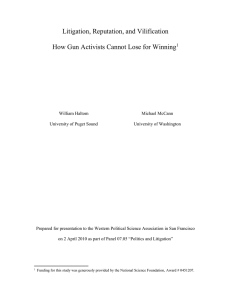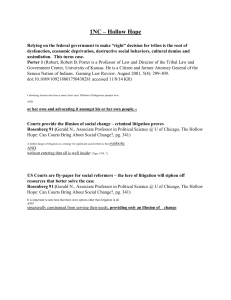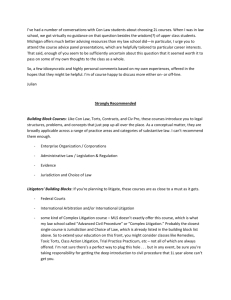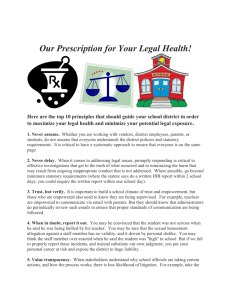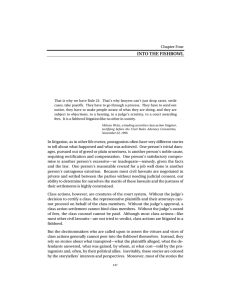“ATTENTION: ALL PERSONS OR ENTITIES”
advertisement
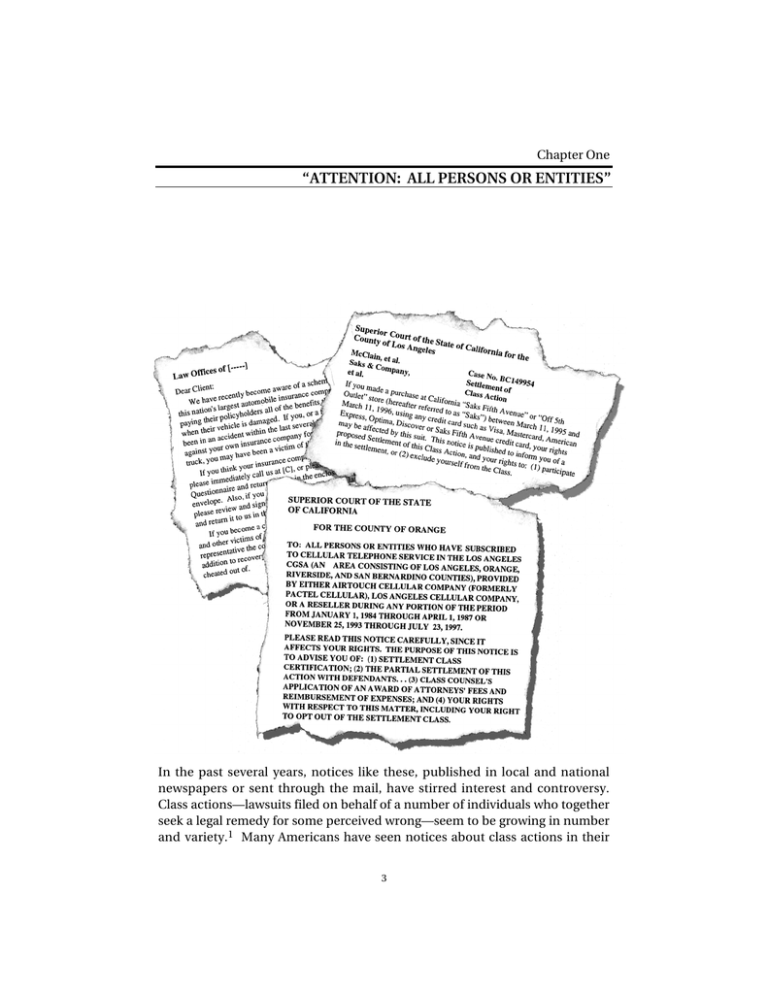
Chapter One “ATTENTION: ALL PERSONS OR ENTITIES” In the past several years, notices like these, published in local and national newspapers or sent through the mail, have stirred interest and controversy. Class actions—lawsuits filed on behalf of a number of individuals who together seek a legal remedy for some perceived wrong—seem to be growing in number and variety.1 Many Americans have seen notices about class actions in their 3 4 Class Action Dilemmas daily newspapers. Many more have learned about high-profile class actions, such as the litigation against tobacco companies, through television and radio. An unknown number of Americans have obtained payments offered as a result of the resolution of class action suits, in amounts ranging from a few dollars to tens of thousands of dollars to much larger sums. Much of the attention focused on class actions now and in the past has been negative. In the 1960s and 1970s, critics opposed the use of class actions to achieve school desegregation, improve prison conditions, and obtain welfare rights. More recently, critical attention has shifted to securities, consumer, and product defect class actions—suits for “money damages.” Critics argue that lawyers seek out opportunities to bring these large-scale suits in the expectation that they will receive large fees, whether or not the suit has underlying merit and whether or not the individuals on whose behalf the suit is brought benefit significantly from its resolution. The critics argue that such class actions impose unnecessary costs on manufacturers and service providers, which are passed on to consumers in the form of higher prices, and that such litigation deters innovation, impairs financial markets, and threatens U.S. economic competitiveness.2 They also argue that misuse of class actions has brought the legal system into disrepute. Notwithstanding this criticism, class actions for money damages have many supporters. Consumer advocates look to these lawsuits to impose penalties for corporate wrongdoing that may result in harms that are quite modest on an individual basis—for example, overcharging individuals by a few cents or a few dollars for each transaction they engage in—but may in the aggregate produce large sums for these companies. When individual losses are small, any one individual who is subject to them is unlikely to file a lawsuit against the corporation. Class actions provide a means of bringing a legal action on behalf of a large number of consumers who may be harmed when corporations engage in wrongful behavior. In the long run, consumer advocates argue, consumers are well-served by lawsuits that succeed in eliminating inappropriate business practices that would otherwise impose unwarranted costs on individuals. Government regulators, as well, often applaud class actions. Because their own ability to enforce regulations is constrained by limited resources—and sometimes by political pressure—some state and federal regulators say they look to class action lawsuits filed by private attorneys to provide additional incentives for businesses to comply with regulations. Corporate representatives are prominent among the critics of money-damage class actions. But corporations themselves sometimes embrace class actions as a means of more efficiently resolving thousands of similar claims, such as “Attention: All Persons or Entities” 5 claims that sometimes arise out of injuries associated with pharmaceutical products, medical devices, or exposure to toxic substances. Criticism of class actions for money damages has led to federal legislation intended to restrain securities class actions. Such criticism has also stimulated efforts to amend Rule 23, the procedural rule that provides for class actions in federal courts, in ways that would probably increase the difficulty of initiating class actions. Because most states have modeled their class action rules on the federal rule, any change in how the federal courts treat class actions is also likely to reverberate through state court systems.3 But policymakers who hear calls to reform class action rules have little objective evidence on class action processes or outcomes to guide their decisions. Why don’t we know more about class actions? Studying this form of litigation is extraordinarily difficult. No national registry exists that can tell us how many class actions there are, or what types of situations lead to them. Much of the controversy over class actions for money damages concerns the practices of parties, lawyers, and judges. Charges and countercharges of unethical behavior abound. The best sources of information on class action litigation practices are the parties, lawyers, and judges involved in class action lawsuits. But while litigation is under way, the stakes are too high for most participants to be willing to share information or views on the process. Once the litigation is concluded, many participants do not want to reveal much about what transpired. In 1996, the RAND Institute for Civil Justice embarked on a study of damage class actions. The Institute is a private, nonprofit organization that has played a leading role in policy debates over civil justice issues by providing empirically based analyses of litigation issues and policy proposals. This book is the product of the study. The study team used a variety of data sources and research approaches to learn about class actions for money damages. We reviewed commentary on the federal class action rule, going back to when it was last significantly modified in 1966. And we studied the most recent attempt to revise the rule, which occupied much of the past decade. We describe the history of the controversy over the federal rule, which frames our later analysis, in Chapter Two. A persistent theme in the debate over class actions has been the lack of information on the numbers and types of cases that are being filed. We assembled data on current class action litigation from a variety of electronic databases and from interviews with leading plaintiff class action attorneys, representatives of Fortune 50 corporations, public interest attorneys, and regulators. In Chapter Three, we use these data to paint a picture of the landscape of class actions toward the end of the 1990s. 6 Class Action Dilemmas Two types of class actions—suits brought on behalf of consumers for relatively small monetary losses and suits brought on behalf of individuals for medical and other losses associated with personal injuries (so-called “mass torts”)— have attracted particular criticism in recent years. The first type is criticized as “lawyer-driven,” intended to line plaintiff attorneys’ pockets rather than benefit consumers. The second type is criticized as trammeling the rights of injured individuals to individualized legal procedures and outcomes. Chapter Three explores the analytic and empirical bases for these charges, drawing on case law, scholarly and practitioner commentary, and our attorney interviews. The chapter closes with a discussion of the dilemmas that damage class actions pose for public policy. Scholarly commentary on class actions deals in broad abstractions, while political rhetoric focuses on a few notorious cases selected to demonstrate a particular point of view. To get beyond the abstractions and away from the focus on “problem cases,” we selected ten recently completed class action lawsuits for deeper study. Most of these cases had not been written about previously, and at the time we selected them for study we did not know what their outcomes had been. To further explore the issues raised in Chapter Three, we selected six consumer cases and four mass tort cases for our analysis. We examined how these cases arose, what was at stake for class members, and what outcomes they achieved, for whom, and at what cost to the parties. Section II reports the results of this phase of our study. Chapter Four briefly describes how we selected the cases for analysis and our research approach. Chapters Five through Fourteen tell the stories of these class action lawsuits. Some readers may not wish to read all of the case studies. But each provides a window into the issues in controversy, and together they provide a rich portrait of the diverse uses of damage class actions in the 1990s. In Section III we return to analysis. Chapter Fifteen considers what the case study data tell us about the “great big question” at the heart of the damage class action controversy: Do they accomplish more good than harm? The charges and countercharges about damage class actions that we reviewed in Chapter Three provide the structure for our analysis. As we examined the historical record, talked with practitioners, and analyzed the data that we had collected, we came to understand better the difficult dilemma that class actions for money damages present to public policymakers. Damage class actions have significant capacity to achieve public goals: to compensate those who have been wrongfully injured, to deter wrongful behavior, and to provide individuals with a sense that justice has prevailed. But what drives damage class actions is private gain: the opportunity they offer lawyers to secure large fees by identifying, litigating, and resolving claims on behalf of large numbers of individuals, many of whom were not previously aware that “Attention: All Persons or Entities” 7 they might have a legal claim and most of whom play little or no role in the litigation process. These financial incentives produce significant opportunities for lawyers to make mischief, to misuse public and private resources for litigation that does not serve a useful social purpose. How to respond to this dilemma is the central question for public policy. The controversy about how to respond to the dilemma posed by damage class actions implicates deep beliefs about the structure of the political system, the nature of society, and the roles of courts and law in society. In democracies such as ours, such controversies often are difficult to resolve and may roil for decades. But at present, many of those on opposite sides of the political controversy over damage class actions share concerns about how class actions are litigated. These shared concerns present opportunities for reform. In the final chapter, we analyze popular proposals for damage class action reform, drawing upon what we learned in our study. Our goal is to identify the approaches that show the most promise for improving the balance between the public and private gains in class action practice—and that offer the best opportunities for finding common ground amidst the controversy. NOTES 1 Class actions may also be used by a group of defendants who choose to be represented in a litigation by a single individual or entity. This book focuses on class actions brought on behalf of multiple plaintiffs, because these lawsuits are more numerous and more controversial. On the infrequent use of defendant classes, see Herbert Newberg and Alba Conte, Newberg On Class Actions 4–181 (Colorado Springs, Colo.: Shepard’s/McGraw-Hill, 3rd ed. 1992). 2Ed Gillespie and Bob Schellhas, Contract with America: The Bold Plan by Rep. Newt Gingrich, Rep. Dick Armey and the House Republicans to Change the Nation (New York: Random House, 1994), at 150. These charges are part of a larger controversy about the impact of civil litigation on the U.S. economy. Analysts have different opinions about the factual basis for such assertions. Peter Huber, Liability: The Legal Revolution and Its Consequences (New York: Basic Books, 1988); Peter Huber and Robert Litan, eds., The Impact of Liability Law on Safety and Innovation (Washington, D.C.: The Brookings Institution, 1991); Peter Schuck, ed., Tort Law and the Public Interest: Competition, Innovation, and Consumer Welfare (New York: W.W. Norton, 1991). 3Rule 23 is one of a set of rules that specify the procedures to be used by litigants and judges in civil litigation in federal courts, which are formally termed the Federal Rules of Civil Procedure. State courts adopt their own rules for governing civil litigation, many of which are identical or similar to the federal rules. Most states have adopted rules for class actions that are modeled after the federal rule. Thomas Dickerson, Class Actions: The Law of 50 States (New York: Law Journal SeminarsPress, 1997) (hereinafter Dickerson, State Class Actions).
